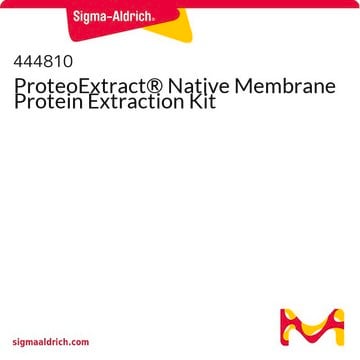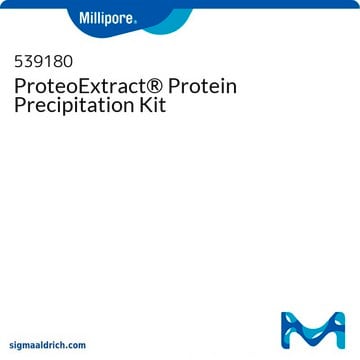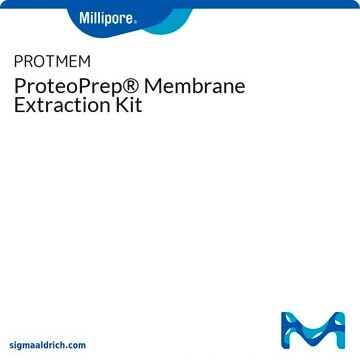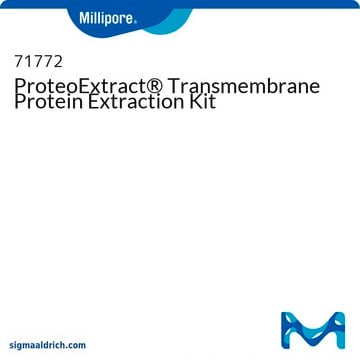539790
ProteoExtract® Subcellular Proteome Extraction Kit
Sinonimo/i:
S-PEK Kit
About This Item
Prodotti consigliati
impiego
sufficient for 20 extractions
Produttore/marchio commerciale
Calbiochem®
Condizioni di stoccaggio
OK to freeze
avoid repeated freeze/thaw cycles
tecniche
fractionation: suitable
input
sample type: mammalian tissue(s)
sample type: mammalian cultured cells
Condizioni di spedizione
ambient
Temperatura di conservazione
2-8°C
Descrizione generale
ProteoExtract® Subcellular Proteome Extraction Kit (S-PEK) is designed for fast and reproducible extraction of subcellular proteomes from adherent and suspension-grown mammalian cells. The S-PEK takes advantage of the different solubilities of certain subcellular compartments in the four selected reagents. In the case of adherent cells, the procedure is performed directly in the tissue culture dish without the need for cell removal. Cells or the parts of the cells remain attached to the plate during sequential extraction of subcellular compartments, until the appropriate extraction reagent is used. Thus, the early destruction of the cellular structure by enzymatic or mechanical detachment of cells from the tissue culture plate and any mixing of different subcellular compartments is prevented. For suspension-grown cells, extraction starts with gentle sedimentation and washing of the cells. The stepwise extraction delivers four distinct protein fractions from one sample:
- Cytosolic fraction (F1)
- Membrane/organelle protein fraction (F2)
- Nucleic protein fraction (F3)
- Cytoskeletal fraction (F4)
Sample size: 3-5x106 or 25-50 mg tissue.
Caratteristiche e vantaggi
- Stepwise extraction resulting in four distinct subcellular proteomes from one sample
- Highly reproducible
- No ultracentrifugation steps
- Fast—needs just 2 hours with 45 minutes hands-on time
- Produces proteins suitable for functional studies
Componenti
Attenzione
Principio
Nota sulla preparazione
The volume of each component required for one subcellular extraction depends on the amount of starting material.
- Adherent tissue culture cells
- Suspension-grown tissue culture cells
- Frozen cell pellets
- Fragmented tissue
Stoccaggio e stabilità
Altre note
Yuan, X., et al. 2002. Electrophoresis23, 1185.
Butcher, et al. 2001. J. Immunol.167, 2193.
Ott, et al. 2001. Pharmacogenomics J.1, 142.
Allen, L. 2000. Nature405, 819.
Dunn, M. J. 2000. Electrophoresis 6.
Rabilloud, T. 2000. Two-dimensional Gel Electrophoresis and Identification Methods Springer-Verlag
Mejdoubi, et al. 1999. Biochem. Biophys. Res. Comm.254, 93.
Reymond, et al. 1997. Electrophoresis18, 2842.
Laemmli, U. K. 1970. Nature227, 680.
Lowry, et al. 1951. J. Biol. Chem.193, 265.
http://www.expasy.ch/ and http://www.expasy.proteome.org.au
Note legali
Classi di pericolo
Aquatic Chronic 3 - Eye Irrit. 2 - Skin Irrit. 2
Classe di pericolosità dell'acqua (WGK)
WGK 3
Certificati d'analisi (COA)
Cerca il Certificati d'analisi (COA) digitando il numero di lotto/batch corrispondente. I numeri di lotto o di batch sono stampati sull'etichetta dei prodotti dopo la parola ‘Lotto’ o ‘Batch’.
Possiedi già questo prodotto?
I documenti relativi ai prodotti acquistati recentemente sono disponibili nell’Archivio dei documenti.
I clienti hanno visto anche
Il team dei nostri ricercatori vanta grande esperienza in tutte le aree della ricerca quali Life Science, scienza dei materiali, sintesi chimica, cromatografia, discipline analitiche, ecc..
Contatta l'Assistenza Tecnica.













